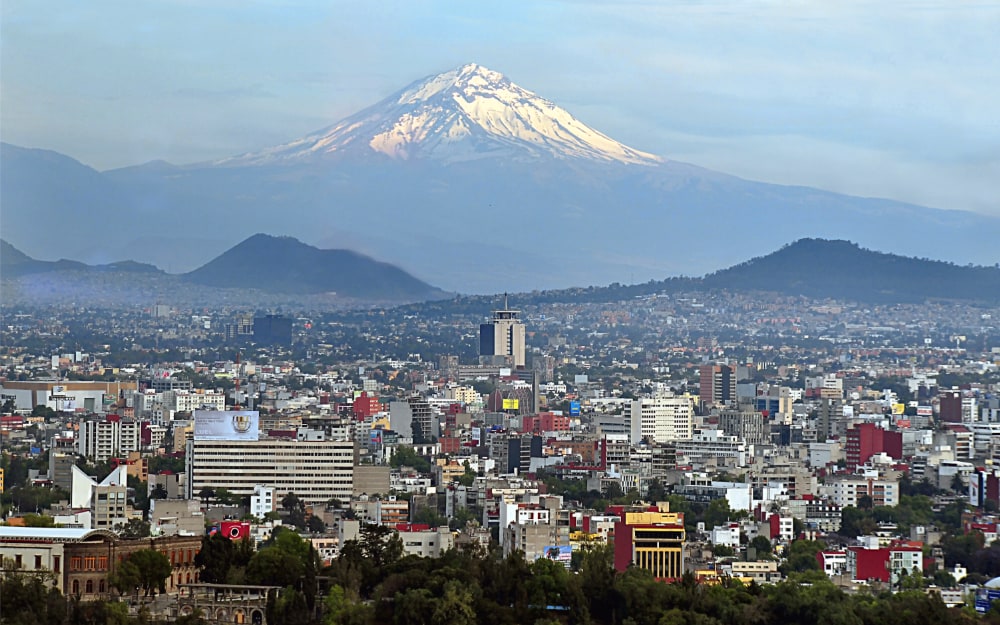Population in Urban Area, now
- World: 6th
- North America: 1st
- Mexico: 1st
Population in City Area, 2021-07-25
- World: 9th
- North America: 1st
- Mexico: 1st
Mexico City Urban Area Population Graph
Mexico City Population Review
Welcome to Mexico City, the capital of Mexico and the most populated city in all of North America. In the past 70 years, Mexico City’s population has grown by leaps and bounds. The city’s population has increased by an incredible 544% since 1950! Now with 21 million people calling Greater Mexico City home, the city has easily become the largest metropolitan area in the Western Hemisphere.
The city has 16 municipalities that stretch across 1,485 square kilometers. The city is surrounded by mountains and volcanoes and rests primarily on what used to Lake Texcoco. While the lake was drained in the 17th century and no water remains, the city continues to suffer sinking, runoff, and wastewater management issues due to the soft lakebed collapsing.
75% of the State of Mexico’s population lives in Mexico City
The State of Mexico (often abbreviated to Edomex from Estado de México) is one of the 32 federal entities that make up Mexico proper. It is also the state in which Mexico City is located. The state contains 14% of the country’s total population, 75% of which live in a municipality that’s part of Greater Mexico City. As of 2010, eight of Mexico City’s 16 municipalities had over 6 million people.
If that seems like a lot of people in a small amount of space, you’re not wrong. Mexico City’s population density is estimated to be 6,000 per square kilometer. Within the Greater Mexico City area the population is even denser, with 9,800 people per square kilometer.
Mexico City has the largest population of US citizens outside of the US
The number of foreigners living in Mexico City has grown by 95% in the last decade, most of which are from the United States. Mexico City has the biggest population of US-citizens living outside of the United States. There are an estimated 700,000 US Americans that currently call Mexico City home (and about one million UX immigrants throughout Mexico).
Wealthy for Mexico, struggling overall
Mexico has a robust economy and the 15th largest GDP in the world. However, about half of all Mexicans live in poverty—and nowhere is that more obvious than in Mexico City. A study in 2004 found that 11% of the urban population was extremely poor and 42% was moderately poor. Much of these issues can be traced back to Mexico City’s inability for its services and housing to keep up with the city’s growth.
Expanding slums
The ever-expanding city and its economic disparity have led to the rise of multiple ghettos and shanti towns. Squatter settlements and slums known as “lost cities” ciudades perdidas have begun to overtake parts of the city, including unused lots, green areas, and areas of dry lake beds. This is especially true in the city’s northweatern and eastern edges. Over the years, many of these slums have built themselves up into permanent areas, like the suburb of Nezahualcóyotl. Originally a small community of about 10,000 people in the 1950s, the suburb has since spread across the lakebed east of the Federal District to accommodate its ballooning population of some 4 million people. It is the largest slum in the city and residents of the slums account for about 10% of Mexico City’s population overall.
Mexican slums are also hotbeds for drug dealing and gang activity. This creates many opportunities for violence and homicides in Mexico City continue to rise, with almost 40,000 registered homicides in the city in 2016. Many homicides and violent crimes also go unreported for fear of revenge from organized criminals.
